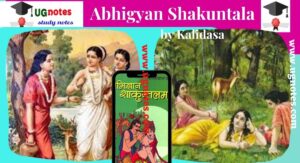Abhigyan Shakuntala By Kalidasa Play: Short Summary
Raichur University Raichur , Gulbarga University, Gulbarga NEP Syllabus
BA III Sem and BA V Sem Optional English Topic
Abhigyan Shakuntala
By Kalidasa
About the writer:
Kalidasa was an ancient Indian poet and playwright who lived in the 4th–5th century CE. He is widely regarded as one of the greatest writers in Sanskrit literature, and his works are celebrated for their beauty, depth, and timeless relevance. Not much is known about Kalidasa’s life, and his exact birth and death dates are uncertain. According to tradition, he lived in the court of the Gupta Empire, one of the most powerful dynasties in ancient India, and was patronized by the emperor himself.
Kalidasa is most famous for his plays, which include “Abhigyan Shakuntalam,” “Malavikagnimitram,” and “Vikramorvasiyam.” His works are known for their intricate plots, vivid descriptions, and lyrical poetry and are considered among the finest examples of classical Indian literature.
In addition to his plays, Kalidasa is also known for his epic poems, such as “Raghuvamsha” and “Kumarasambhava,” which recount the lives and deeds of legendary Indian kings and gods.
A short summary of the play:
“Abhigyan Shakuntalam” is a play written by the ancient Indian playwright Kalidasa, which tells the story of King Dushyanta and his love for Shakuntala, a young maiden he meets in the forest.
The play begins with Shakuntala living with her adoptive father, the sage Kanva, in a hermitage in the forest. One day, King Dushyanta visits the hermitage while on a hunting expedition and is struck by Shakuntala’s beauty. They fall in love and secretly get married.
However, soon after, Dushyanta is called back to his kingdom and must leave Shakuntala behind. He gives her a ring as a symbol of their love and promises to return it for her. But when Shakuntala tries to join him in the city later, she is rejected by the king, who has lost his memory of her due to a curse. Heartbroken, Shakuntala returns to the forest and gives birth to a son, Bharata.
Eventually, the curse is lifted, and Dushyanta remembers his love for Shakuntala. He sets out to find her and his son and is eventually reunited with them in the forest. The play ends with the happy reunion of the family.
“Abhigyan Shakuntalam” is known for its beautiful poetry and its exploration of themes such as love, loyalty, and the power of fate. It is considered one of the greatest works of Indian literature and has been widely translated into various languages.
OR

Abhijnanashakuntala (Sanskrit: “The Recognition of Shakuntala”) is a drama by Kalidasa composed in the 5th century CE that is generally considered to be the greatest Indian literary work of any period.
Taken from legend, the work tells of the seduction of the nymph Shakuntala by King Dushyanta, his rejection of the girl and his child, and their subsequent reunion in heaven. The child that is born is Bharata, the eponymous ancestor of the Indian nation (Bharatavarsha, “Subcontinent of Bharata”). Kalidasa remakes the story into a love idyll whose characters represent a pristine aristocratic ideal: the girl, sentimental, selfless, alive to little but the delicacies of nature, and the king, first servant of the dharma (religious and social law and duties), protector of the social order, resolute hero, yet tender and suffering agonies over his lost love. The plot and characters are made believable by a change Kalidasa introduces: Dushyanta is not responsible for the lovers’ separation; he acts only under a delusion caused by a sage’s curse. As in all of Kalidasa’s works, the beauty of nature is depicted with an inimitable elegance of metaphor.











